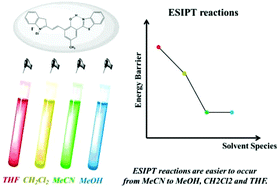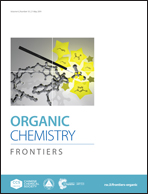The solvent effect on the excited-state intramolecular proton transfer of cyanine derivative molecules
Abstract
Lysosome organelles which contain many digestive and degradative enzymes play a crucial role in metabolizing some residual proteins and nucleic acids in biological cells. In view of this, a typical ESIPT chromophore for detecting the lysosomes was synthesized in an experiment [D. Dahal, et al., Chem. Commun., 2017, 53, 3697–3700]. Unusually large Stokes shifts are observed in different solvents and are supposed to be related to the ESIPT process. However, the mechanism of the ESIPT reaction cannot be simply analyzed by spectrum experiments. In our research, we perform the state-of-the-art ab initio excited-state computation for this chromophore. The calculated electronic spectral values are well matched with the observed spectral values in the experiment, confirming that the abnormal large Stokes shifts of fluorescence are generated by ESIPT reactions. The analyses of frontier molecular orbitals give molecular-level insight into the photophysical properties. The calculated hydrogen-bond parameters and vibrational frequencies indicate a decreasing order of excited-state hydrogen bonding (ESHB) strength from MeCN to MeOH, CH2Cl2 and THF. What's more, the calculated Mulliken charges reveal that the sequence of ESHB strengths depends on the influences of electronegativity of a proton donor and acceptor. Based on the constructed reactive potential energy curves, we systemically investigate the effect of solvation on the ESIPT mechanism of a cyanine derivative. Finally, the calculated reactive energy barriers quantitatively illuminate that ESIPT reactions are easier to occur from MeCN to MeOH, CH2Cl2 and THF.



 Please wait while we load your content...
Please wait while we load your content...